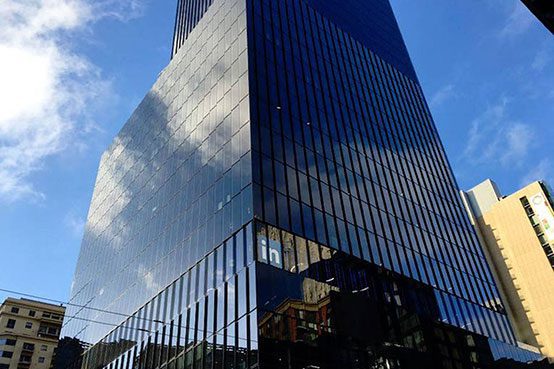Today’s Skyscrapers Assault the Skyline and the Street

Why do we dislike modern skyscrapers? Well, most of us do, at least.
The architects, as well as the reviewers for fashionable architectural journals, tell another story: These buildings—the recently completed LinkedIn building in San Francisco, for instance—are expressions of the time in which we live, are full of the energy and defiance of the Internet society, are the presence of youth in the decaying structures of the past, and… Well, you can fill in the gaps for yourself. Just remember to use the buzzwords—vibrant, exciting, challenging, cutting edge—and you will have produced an impeccable work of architectural criticism, suitable for even the glossiest magazine.
But those buzz words provide the real answer to my question. “Cutting edge,” for instance: Is that not a perfect description of the edges of the LinkedIn building, which neither bend to accommodate the neighbors nor retreat from the line of the street, but simply cut and slash their way to domination? And is that what we want from a vast building in the centre of a once beautiful city? “Exciting,” “vibrant,” and the other millennial clichés: Do we really want to live among buildings with attributes like those?
Think of the old center of Boston: not an excitement to be found, only quiet, polite façades standing side by side in conversation, symbols of a world at peace with itself—except, of course, for the 1968 Boston City Hall, that chunk of vibrant concrete that has created all around itself a desert of disaffection.

It is not the cutting edge that we ordinary observers want, but the gentle and retreating edge, the cheerful pinnacle and the polite façade. Look at the first generation of skyscrapers and you find those things in abundance. The lovely pinnacle of New York City’s Chrysler Building, for example, which does not assault the sky like an angry fist, but proudly stands above the city like a cathedral spire, puncturing the sky but also gently repairing the injury. Those old skyscrapers followed the line of the street, so that their edges did not jostle their neighbours aside, but simply rose beside them, conceding space at street level. And the meeting of the building and the street was not, as it now so often is, an abrupt horizontal, like a crushing block of concrete on the toe, but a collection of colonnades and arches, a busy labyrinth of welcomes, that blended with the doors and windows to either side.
We learn from those old skyscrapers that the height of a building does not in itself detach it from the city. There are critical points where building and city meet, and where it is good manners rather than “cutting-edge” excitement that are most required. These points are three: the skyline, the street line, and the vertical order that unites them.
Study those things and you will quickly find an answer to my question. The modern skyscraper has no skyline: merely a blunt fist thrust above the city, without grace or courtesy. It has no façade at street level, but merely an opening somewhere, marked if at all by some garish logo, and surrounded by characterless steel and glass. And the two extremities are not joined together in any meaningful way, since the only vertical lines are the sharp forbidding edges of the building, brandished like threats towards the buildings to either side. Top and bottom are simply the first and last of a stack of trays, producing an effect of accumulated horizontals in which all vertical order—all true posture towards the city—is lost in a vision of junk.
Roger Scruton is The American Conservative’s New Urbanism Fellow.
Comments